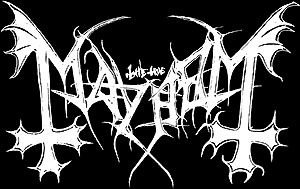Like a dark breath of forbidden fantasy, black metal came into a world of orderly containers and sprayed them with foaming blood, black bile, and most of all a poisonous uncertainty about the safely egalitarian but boring lifestyle of the first world. In this genre, Mayhem were the band that by sheer persistence evolved into being one of the founders of the new black metal style, but only after years of thrashing in the dark and confusion of the fatalistic tendencies that eventually brought the band to artistic collapse.
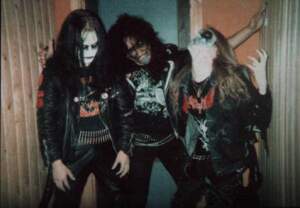 Formed in the early 1980s by Oystein Aarseth, or Euronymous, the band released two demos which built upon what Bathory and Celtic Frost had achieved by making it more minimal, less coherent, and less friendly to the ears; in truth, the first anti-social music. The latter of these, “Pure Fucking Armageddon,” had attributes of extreme crustcore infused into its fractured heavy metal stylings, bringing criticism from a metal world which was then just beginning to accept Morbid Angel, Kreator, Destruction and others as a new form of “music.”
Formed in the early 1980s by Oystein Aarseth, or Euronymous, the band released two demos which built upon what Bathory and Celtic Frost had achieved by making it more minimal, less coherent, and less friendly to the ears; in truth, the first anti-social music. The latter of these, “Pure Fucking Armageddon,” had attributes of extreme crustcore infused into its fractured heavy metal stylings, bringing criticism from a metal world which was then just beginning to accept Morbid Angel, Kreator, Destruction and others as a new form of “music.”
As time went on, two important things happened: first, Mayhem released “Deathcrush,” their first release and the best snapshot of the musical style they were attempting to produce, and second, the vocalist “Dead” [Per Yngwe Ohlin] from the Swedish band Morbid joined Mayhem to replace previous vocalist Maniac. The underground was slow at first to embrace the newer music, but soon there was a firm niche carved out for Mayhem: those who rejected the desire for logicality, in the modernist style, that death metal represented. As Euronymous said, “Black Metal is so extreme that not anyone can get into it. This isn’t any funny hobby which stupid kids shall have after they comes home from school.”
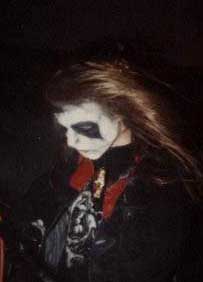 With the introduction of Dead, the conceptual impetus behind the band changed, and soon the blocky and deliberately awkward music of “Deathcrush” was metamorphosizing into a sleeker, melodic variant with more dynamic change in the songs, producing different “settings” to tell a tale, somewhat like a micro-opera in harsh guitars and howling vocals. Similarly, the appearance of the band went from t-shirts and jeans to black clothing, black boots and facepaint – corpsepaint – in black and white. In concert, Dead cut himself onstage, surrounded by the carcasses and heads of slaughtered animals. A full rejection of the positivity, pity and focus on individual lives of democratic humanism, the new appearance and music of Mayhem emphasized the bold, terrifying, morally ambiguous and deathlike in life itself. To understand it, one had to realize that the passion given to the music was an affirmation of life, but a different form of life, than that endorsed by the nominally Christian Nordic countries.
With the introduction of Dead, the conceptual impetus behind the band changed, and soon the blocky and deliberately awkward music of “Deathcrush” was metamorphosizing into a sleeker, melodic variant with more dynamic change in the songs, producing different “settings” to tell a tale, somewhat like a micro-opera in harsh guitars and howling vocals. Similarly, the appearance of the band went from t-shirts and jeans to black clothing, black boots and facepaint – corpsepaint – in black and white. In concert, Dead cut himself onstage, surrounded by the carcasses and heads of slaughtered animals. A full rejection of the positivity, pity and focus on individual lives of democratic humanism, the new appearance and music of Mayhem emphasized the bold, terrifying, morally ambiguous and deathlike in life itself. To understand it, one had to realize that the passion given to the music was an affirmation of life, but a different form of life, than that endorsed by the nominally Christian Nordic countries.
With this change, the following of Mayhem increased, especially as their recognizably different image placed them ahead of other musical efforts in the world of metal as less socialized and thus more extreme. Mayhem played a series of concerts across Europe, but recording and songwriting were sporadic, thus little material emerged from this period. At the end of it, Dead, in a moment of nihilism and darkness in 1991, slashed both his wrists and blew out his brains with a shotgun, leaving only a note: “Please excuse all the blood.” Euronymous, upon returning to the band’s shared dwellingspace to discover the cold corpse, took pieces of the brain and integrated them in a stew of ham and vegetables for the pleasure of eating human flesh; the band’s drummer, Hellhammer, took pieces of the shattered skullcap and made them into a necklace. As if a primitive ritual, the members of Mayhem paid their respects in death as in life: with coldness, feral opportunism, and a denial of any “sanctity” or “feelings” toward life, even that of a friend and collaborator. As Euronymous said later, about his form of “evil,” “It is basically hate to humankind. I have no friends, just the guys I’m allied with. If my girlfriend dies I won’t cry, I will missuse the corpse.”
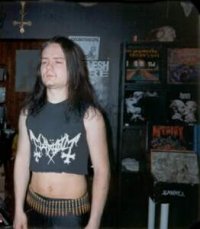 During this time, Euronymous and his band were instrumental in the forming of a new black metal social group, or “scene,” centered around his record store in Oslo called Helvete [Hell]; the downstairs was a necrotic and bleak excuse for a commercial establishment in which the hatred and disassociation from commercial process was as much a barrier to purchase as anything else, but the upstairs was a practice room where Nazi flags and weapons hung over instruments decorated with inverted crosses. During the daytime, the store was a gathering place for musicians and fans of an anti-social nature; at night, Euronymous indoctrinated those who might be useful to the scene by inviting them to wild parties in which orgiastic appetites for alcohol fueled self-mutilation and eventually, rampant church and graveyard desecration [in Europe and many older American towns, the graveyard surrounds the church – a strangely forthright admission of the role of religion in society!]. Euronymous also started the first record label of the modern black metal movement, Deathlike Silence Productions. While these events stood against everything that Norwegian society of the time valued, authorities were permissive and did not “connect the dots” until far later.
During this time, Euronymous and his band were instrumental in the forming of a new black metal social group, or “scene,” centered around his record store in Oslo called Helvete [Hell]; the downstairs was a necrotic and bleak excuse for a commercial establishment in which the hatred and disassociation from commercial process was as much a barrier to purchase as anything else, but the upstairs was a practice room where Nazi flags and weapons hung over instruments decorated with inverted crosses. During the daytime, the store was a gathering place for musicians and fans of an anti-social nature; at night, Euronymous indoctrinated those who might be useful to the scene by inviting them to wild parties in which orgiastic appetites for alcohol fueled self-mutilation and eventually, rampant church and graveyard desecration [in Europe and many older American towns, the graveyard surrounds the church – a strangely forthright admission of the role of religion in society!]. Euronymous also started the first record label of the modern black metal movement, Deathlike Silence Productions. While these events stood against everything that Norwegian society of the time valued, authorities were permissive and did not “connect the dots” until far later.
It was at this time that many of extremist views, such as the skinhead-turned-rocker Kristian Vikernes – also performing in Burzum, joined the circle – and joined Mayhem on bass. Vikernes was an interesting counterpoint to those in the association so far; he was a hater of life but, like Dead, had an uncanny passion for life through art, and seemed to value his time in nature, away from people and their imaginary rules. His intent could be summarized in his most clarion statement, “I see Burzum as a dream without holds in reality. It is to stimulate the fantasy of mortals, to make them dream” – a replacement of morality with the über-Romanticist ethos of adventure and heroic classicism. Between the Gothic neoclassicism of Dead and the postmodern Romanticism of Vikernes, black metal became more than a style of music, but an ideological and social tool for change away from a highly regimented, moralistic society. Vikernes again: “We want to create the most possible fear, chaos and agony so that the idiotic and friendly Christian society can break down. We are overall not interested in that the truth comes through. When we spread lies we cause confusion and confusion leads to chaos and at last breakdown. People shall be oppressed and we support everything that oppresses man and takes from him his feelings as free individuals.”
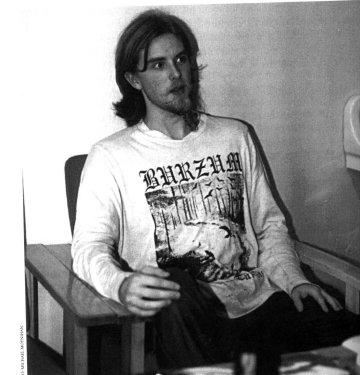 It was part of this denial of the supremacy of the lives of individuals over ideas, emotions and even real-world activities that helped what happened next to occur. Two polar opposites existed in black metal, the fatalism and negativity of Euronymous versus the political and violent doctrine of Vikernes, and these were brought into conflict through the personalities. Vikernes claims Euronymous delayed the release of Burzum albums [on Deathlike Silence] by spending the money instead on degenerate pursuits; Euronymous presumably did not care and was more interested in the upcoming Mayhem release, which was moving slowly because of the personality conflicts in the band. Eventually, reality followed imaginary projections: on the night of August 10, 1993, Euronymous was stabbed to death by Vikernes; of 26 knife wounds, 2 were to the head, five to the neck and 19 to the back. Thus began the projection of Mayhem into legend, since it provided black metal in the modern sense with not only its first model of technique and imagery, but also its first martyrs. Dead was eulogized in a 1992 release, “Live in Leipzig,” which recorded an excessively bloody and violent Mayhem concert in East Germany. Teaming up with Attila Csihar of Tormentor, the remaining members of Mayhem put out “De Mysteriis Dom Sathanas,” one of the most impassioned black metal albums released, yet one with its feet firmly grounded in old-school Venom/Bathory heavy metal styles. Their nihilism was so great they left Vikernes’ bass tracks on the album next to the guitar work of the man he killed, claiming in the press to have removed them so not to attract unwelcome attention from his family.
It was part of this denial of the supremacy of the lives of individuals over ideas, emotions and even real-world activities that helped what happened next to occur. Two polar opposites existed in black metal, the fatalism and negativity of Euronymous versus the political and violent doctrine of Vikernes, and these were brought into conflict through the personalities. Vikernes claims Euronymous delayed the release of Burzum albums [on Deathlike Silence] by spending the money instead on degenerate pursuits; Euronymous presumably did not care and was more interested in the upcoming Mayhem release, which was moving slowly because of the personality conflicts in the band. Eventually, reality followed imaginary projections: on the night of August 10, 1993, Euronymous was stabbed to death by Vikernes; of 26 knife wounds, 2 were to the head, five to the neck and 19 to the back. Thus began the projection of Mayhem into legend, since it provided black metal in the modern sense with not only its first model of technique and imagery, but also its first martyrs. Dead was eulogized in a 1992 release, “Live in Leipzig,” which recorded an excessively bloody and violent Mayhem concert in East Germany. Teaming up with Attila Csihar of Tormentor, the remaining members of Mayhem put out “De Mysteriis Dom Sathanas,” one of the most impassioned black metal albums released, yet one with its feet firmly grounded in old-school Venom/Bathory heavy metal styles. Their nihilism was so great they left Vikernes’ bass tracks on the album next to the guitar work of the man he killed, claiming in the press to have removed them so not to attract unwelcome attention from his family.
While the lives of its members had mostly run their course, and its most epic work had been produced, at least in conceptual form, before these deaths, afterwards the social and political importance of Mayhem was fully recognized. First, it gave many a central point with which to identify the new movement, and generated a wave of publicity especially in unison with the news of 22 churches burned in Norway, mostly by black metal “Satanists.” Even more importantly, Euronymous himself became a central figure, and his ideas [and those of Dead and Vikernes, who heavily influenced him] became dissected and discussed across the globe. Not only was this influential in the fanbase, but labels and bands worldwide began to see the importance of the new black metal movement: unlike anything from popular music since the 1960s, this was shocking; the people in black metal lived on the edge and fought to the death, something metal bands had always sung about but never acted out, much to the derision of punkers and other underground fans. The image of Helvete – the church of the anti-life – became predominant in the minds of many when conceptualizing new forms of social expression to the anti-oversocialization impetus that black metal and heavy metal share. In the years following the death of Euronymous, the focus he brought to the scene brought it to a dramatic rise and sudden death, as in late 1997 the genre became swamped with commercial bands in the mainstream style.
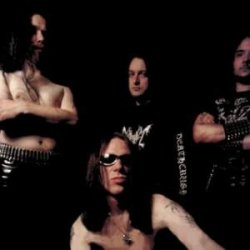 Mayhem itself continued on in the form of two major works, “Wolf’s Lair Abyss” in 1997 and “A Grand Declaration of War” in 2000, interspersed with numerous live albums and re-releases. where “De Mysteriis…” continues to be their most popular work, “Wolf’s Lair Abyss” is regarded by many as a highly proficient black metal album in the style of Satyricon mixed with old Mayhem, producing something with the same rhythmic thrust as “De Mysteriis” but with less of the operatic lack of total consistency in songs. “A Grand Declaration of War” is more problematic, taking a divergence into math-metal and pseudo-progressive stylings, which creates an album which sounds more like soundtrack than foreground listening, with Marilyn Manson influences in both songwriting and image. Because of this, and other factors such as the vast commercialization of black metal during the last six years, Mayhem is effectively dead in the underground and a small player with a devoted fanbase in the mainstream metal scene at this time. However, for every person who gets into black metal, the chorus of voices suggesting “De Mysteriis…” has an effect, for people continue to buy it at a great rate and praise it as immortal metal music and unmatched spirit in a genre filled mostly with angry people of little imagination.
Mayhem itself continued on in the form of two major works, “Wolf’s Lair Abyss” in 1997 and “A Grand Declaration of War” in 2000, interspersed with numerous live albums and re-releases. where “De Mysteriis…” continues to be their most popular work, “Wolf’s Lair Abyss” is regarded by many as a highly proficient black metal album in the style of Satyricon mixed with old Mayhem, producing something with the same rhythmic thrust as “De Mysteriis” but with less of the operatic lack of total consistency in songs. “A Grand Declaration of War” is more problematic, taking a divergence into math-metal and pseudo-progressive stylings, which creates an album which sounds more like soundtrack than foreground listening, with Marilyn Manson influences in both songwriting and image. Because of this, and other factors such as the vast commercialization of black metal during the last six years, Mayhem is effectively dead in the underground and a small player with a devoted fanbase in the mainstream metal scene at this time. However, for every person who gets into black metal, the chorus of voices suggesting “De Mysteriis…” has an effect, for people continue to buy it at a great rate and praise it as immortal metal music and unmatched spirit in a genre filled mostly with angry people of little imagination.
Regardless of the current tedium of record sales and popularity contests, Mayhem contributed an indelible influence on not only metal, but music of resistance to socialization as a whole. Their ideology – part blank-faced fatalism, part fascism and part feral atavism – was carried upwards by the voices of many who were similarly frustrated with the pity-oriented egalitarian society of the first world, which preached that avoiding death was more important than achieving heroic or passionate things. Against this belief system black metal, and Mayhem most visibly, agitated. “True satanists are superhumans,” stated Euronymous in a now-infamous interview. A few years later, Vikernes gave a clearer view: “Strife is evolution, peace is degeneration.” This did not sit well with not only Christians and Jews, but also many people who had become dependent upon society and its pity toward those who are less-able as a whole, thus raising a cry against black metal as music of “hate” or “intolerance.” While those would clearly like to file black metal into a wholly political category, the raw artistry and imagination of bands like Mayhem make that appear a one-dimensional look at the story. As Ihsahn from fellow Nordic rockers Emperor said, “You’ll never understand me because you sit in the audience at a horror movie. I’m up on the screen.” There is no place in the current society for bands like Mayhem; they are beyond its rules and mental conditioning, and always will be. And for this, wherever anguish at social predominance grinds, there will be new fans of the fundamental works of Mayhem, which not only outlive their creators but will forever be a mythos larger than life itself.
1 CommentTags: Black Metal, Euronymous, mayhem, metal history, norway
